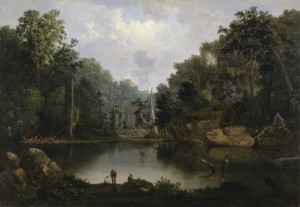![The Hellbender is the largest North American salamander, and one of the most elusive since it lives under rocks in the bottoms of rivers. Now its whereabouts can be detected by assaying its DNA in river water. [Image source: NPR/Robert J. Erwin/Science Source]](http://media.npr.org/assets/img/2013/07/24/hellbender_wide-a0689730ea6eb1966ac24cc72575cf27a4d1e8e6-s40.jpg)
The Hellbender is the largest North American salamander, and one of the most elusive since it lives under rocks in the bottoms of rivers. Now its whereabouts can be detected by assaying its DNA in river water. [Image source: NPR/Robert J. Erwin/Science Source]
via What’s Swimming In The River? Just Look For DNA : NPR 072413.
If you want to protect rare species, first you have to find them. In the past few years, biologists have developed a powerful new tool to do that. They’ve discovered that they can often find traces of animal DNA in streams, ponds — even oceans.
The idea took root just five years ago, when biologists in France found they could detect invasive American bullfrogs simply by sampling pond water and looking for an exact genetic match to the frogs’ DNA.
Now, all sorts of biologists are eagerly putting this test to use. The technology has been a hot topic at the Society for Conservation Biology’s global meeting in Baltimore this week.
The Elusive ‘Snot Otter’
Conservation scientist Stephen Spear, for example, has been sampling water to study one of the oddest creatures in American streams: the hellbender salamander.
“It’s a really neat critter. It’s actually the largest salamander in North America,” he says. It can grow up to 2 feet long and live for more than 30 years.
“But a lot of people who live where it is — which is mostly in the Appalachian region from New York to Georgia — don’t know about it because it’s totally aquatic in rivers and streams,” Spear says. “It spends time under large rocks.”
Biologists usually look for the hellbender (nicknamed the “snot otter”) by prying up enormous stream boulders and snorkeling under them. Spear, who works for a nonprofit amphibian group called The Orianne Society, has found a gentler way: He’s been taking water samples from the streams where he’s looking for these salamanders.
“We can actually extract the DNA from this water sample and be able to tell that it’s hellbender DNA. And we know that a hellbender is there without ever having to lift a rock, or maybe even see one,” he says.
And it turns out that when hellbenders are breeding, they shed a lot more DNA into the water. “So we might be able to tell where they’re successfully breeding,” Spear says, “which would be huge for understanding where the healthy populations are and also where we need to put our conservation efforts.”
Hellbenders are apparently in decline — and may end up protected by the Endangered Species Act at some point — so it’s important for biologists to know where they are and where they’re breeding.


![Sandhill cranes land on Platte River sandbar roosts west of Rowe Sanctuary’s Iain Nicolson Audubon Center southwest of Gibbon, Nebraska. [Photo by Lori Porter| Kearney Hub]](https://www.ghostturtles.com/wp-content/uploads/2015/03/sandhill_cranes_kearneyhub_032015-300x225.jpg)
![An endangered Whooping crane takes flight. Yhe large bird has a 7-foot wingspan. It is all white except for black wing tips and face markings. In this photo its long neck stretches forward; its wings sweep upward; and its black legs trail straight behind it. [Source: International Crane Foundation]](https://www.ghostturtles.com/wp-content/uploads/2023/03/Whooping-crane-eastern-ICF-080622-300x157.jpg)

![Mark Willis peruses a 1745 volume by Voltaire at a bouquiniste book stall on the banks of the Seine in Paris. He wears a brown leather jacket and checkered flat cap. He holds the open book in his hands. Rows of old books are seen on shelves behind him. [2005 photo by Ms. Modigliani]](https://www.ghostturtles.com/wp-content/uploads/2023/03/mw_bouquiniste_05-300x225.jpg)


